2016 Honda Civic Sedan - Safety and Driver Assistance Specs, Features and Details +VIDEO
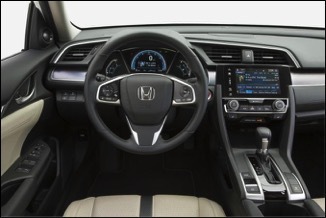 |
(See the Specifications and Features section for all data.)
LOS ANGELES - October 19, 2015: With advanced, unibody engineering, the greatest use of high-strength steel in Civic model history, and a wide array of advanced passive-safety features, the 2016 Civic Sedan was designed to achieve a superb level of active and passive safety performance for vehicle occupants – as well as for the occupants of other vehicles and other road users, including motorcycle and bicycle riders and pedestrians.
For the first time, Civic can be equipped with Honda Sensing™, among the most comprehensive suites of safety and driver-assistive technologies in the competitive class, including the first application of Adaptive Cruise Control with Low-Speed Follow to a Honda vehicle.
Standard passive-safety features such as a new driver's Spiral Airbag and a new front passenger's safety vent airbag, SmartVent® front side airbags, and side curtain airbags with rollover sensor help protect occupants in a collision. In addition, the greater use of high-strength steel and advanced crash engineering features, including its Advanced Compatibility Engineering™ (ACE™) body structure, new crash stroke front frame rails, and tailor-tempered B-pillars and rear frame structures, helps better protect occupants in a collision while minimizing weight for superior fuel efficiency.
Key Safety and Driver Assistive Features
- Next-generation Advanced Compatibility Engineering™ (ACE™) body structure with new crash stroke design
- Hot-stamped ultra-high-strength steel door rings and sills
- Multi-Angle Rearview Camera1
- Expanded View Driver's Mirror
- Seatbelts with Crash Locking Tongue*
- Indirect Tire Pressure Monitoring System (TPMS)2 *
- Honda LaneWatch™3
- Available Honda Sensing™ package:
- Collision Mitigation Braking System (CMBS)4 *
- Forward Collision Warning (FCW)5 * – Integrated into CMBS
- Lane Departure Warning (LDW)6 * – Integrated into RDM
- Road Departure Mitigation (RDM)7 *
- Lane Keeping Assist System (LKAS)8 *
- Adaptive Cruise Control (ACC)9 * with Low Speed Follow (LSF) *^
* First for Civic
^ First for Honda
Top Safety Ratings
The Civic was engineered to earn
top-class collision safety ratings. In particular, these include a 5-Star
Overall Vehicle Score from the National Highway Traffic Safety
Administration (NHTSA) in its New Car Assessment Program (NCAP), along with
a TOP SAFETY PICK+ rating from the Insurance Institute for Highway
Safety (IIHS). A significant area of improvement is the goal of achieving a
Good rating in the latest IIHS small overlap frontal crash test.
Crash Safety Ratings (Predicted)
| Rating |
2016 Civic (Internal test results) |
|
NHTSA Overall Vehicle Score |
5-Stars |
|
NHTSA Overall Frontal Crash |
5-Stars |
|
NHTSA Overall Side Crash |
5-Stars |
|
NHTSA Rollover |
5-Stars |
|
IIHS safety award |
TOP SAFETY PICK+ |
|
IIHS Small overlap front |
Good |
|
IIHS Moderate overlap front |
Good |
|
IIHS Side |
Good |
|
IIHS Roof strength |
Good |
|
IIHS Head restraints & seats |
Good |
|
IIHS Front crash protection |
Superior |
Pedestrian Injury Mitigation Design
Structures in
the front of the 2016 Civic are designed to help absorb energy in the event
of a collision with a pedestrian. Research by Honda shows that the
following features can dramatically improve a pedestrian's chance of
survival if struck by a moving vehicle.
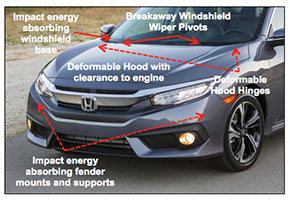
Specific pedestrian head injury mitigation features include:
- Hood is designed to deform if contact is made with either an adult or a child pedestrian
- Sufficient clearance exists between the hood and hard engine parts, allowing the hood to deform if impacted by a pedestrian
- Windshield base has a unique section structure for efficient impact energy absorption
- Energy-absorbing fender mounts and supports
- Breakaway windshield wiper pivots
- Deformable hood hinges

Vehicle Stability Assist™ (VSA®) with Traction
Control
Vehicle Stability Assist™ (VSA®)10 is
an Electronic Stability Control system that works in conjunction with the
Drive-by-Wire™ throttle and its 4-channel ABS systems to enhance
control capability while the vehicle is accelerating, braking, cornering or
when the driver makes a sudden maneuver. VSA functions by applying brake
force to one or more wheels independently while also managing the throttle,
ignition and fuel systems to help the vehicle maintain the driver's
intended path of travel.
The VSA system constantly analyzes data from sensors that monitor wheel speed, steering input, lateral and longitudinal G forces and yaw rate. It compares the driver's control inputs with the vehicle's actual response. Whenever the actual response falls outside of a predetermined acceptable range, VSA intervenes with a corrective action. For instance, if VSA detects an oversteer condition, the system may apply braking force to the outside front and rear wheels to counteract the unintended yawing effect. In the event of understeer, VSA may apply braking to the inside rear wheel while reducing engine power to help return the vehicle to its intended course.
VSA also provides a limited-slip differential effect for the front wheels by applying braking force to a slipping wheel, thereby redirecting driving force to the wheel with more traction. VSA is calibrated to function in a near-transparent manner, and in many cases a driver will not even be aware of its operation. However, anytime the system is enhancing vehicle stability, an indicator light flashes in the instrument cluster. While the driver can reduce the traction control effectiveness allowing more wheel slip during stuck condition by pressing the VSA button, ABS remains fully operational at all times. See Page 81 for an image of the VSA Off button.

Motion-Adaptive Electric Power Steering (EPS)
Motion-Adaptive Electric Power Steering (EPS) is standard on all 2016 Civic
models. The system incorporates driving stability technology that initiates
steering inputs that prompt the driver to steer in the correct direction
during cornering and in slippery road conditions. Using vehicle speed and
steering angle data, Motion-Adaptive EPS works with Honda's Vehicle
Stability Assist (VSA®)10 and Electric Power Steering to detect
instability in slippery road conditions both during cornering and under
braking and automatically initiates steering inputs aimed at prompting the
driver to steer in the correct direction. This advanced technology supports
the driver's action in operating the vehicle more safely and
comfortably.
Two examples of how Motion-Adaptive Electric Power Steering (EPS) functions in conjunction with VSA are:
Stabilizes Vehicle under Braking
This function
helps to correct the driver's steering input to reduce vehicle instability
when the driver is braking hard on road surfaces with different friction
coefficients (such as pavement that is partially covered with dirt or
snow).
Mitigates Understeer and Oversteer
To mitigate
potential understeer or oversteer situations, the system helps correct the
steering inputs to help the driver trace the curve.
(See the Chassis section for more information.)
Brake Assist
A function of the VSA®
system10, the Brake Assist feature recognizes emergency braking
situations and almost instantly applies added braking force. This Brake
Assist feature is controlled by a special logic in the system that
evaluates the pedal application rate and force to recognize a panic stop
situation. At that point, the VSA modulator pump increases braking pressure
while the pedal is still being pressed to ensure maximum stopping force, an
action that can help shorten braking distance.
Advanced 4-Channel ABS with Electronic Brake
Distribution
For the first time, all Civic trims are fitted
with 4-wheel disc brakes with four-channel anti-lock braking (ABS). The ABS
system also incorporates Electronic Brake Distribution (EBD) circuitry that
automatically proportions front-to-rear brake force based on the vehicle's
dynamic load on each wheel. Larger front brake disc dimensions and a larger
master cylinder improve stopping performance and pedal feel. (See
the Chassis section for more information.)
Seatbelts
Three-point seatbelts are standard for
all seating positions. The front seatbelts are equipped with pyrotechnic
pretensioners and load limiting retractors to help minimize injury
potential in a frontal collision. When an impact occurs, the automatic
tensioner tightens the seatbelt (shoulder and lap) to help hold the seat
occupant firmly in position. Each front seatbelt retractor incorporates a
load limiter that works in conjunction with the automatic tensioner. The
load limiter functions by permitting a small amount of controlled seatbelt
slack shortly after the automatic tensioner is activated to limit the peak
restraining forces and thereby reducing the potential of serious injury.
The front seatbelts also feature adjustable-height shoulder anchors. To
help increase seat-belt usage, a reminder for the driver and front
passenger has been incorporated into the instrument cluster. After starting
the vehicle, a weight sensor detects whether the front passenger seat is
occupied. If the driver or front passenger has not already fastened the
seat belt, an icon in the cluster illuminates and a chime sounds as a
reminder to do so.
Crash Locking Tongue
The Civic's front seatbelts
use a "crash locking tongue" latch plate design that locks the webbing in
place during a collision, helping to better restrain the occupant. During
normal driving conditions the seatbelt webbing moves freely through the
latch plate in the normal manner. However in the event of a collision,
forces exerted on the lap and shoulder sections of the seatbelt push the
webbing against a "reaction surface" inside the latch plate, locking the
webbing in place.
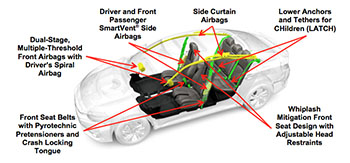
Dual-stage, Multiple-Threshold Front Airbags
Both
the driver and front passenger are protected by advanced front airbags
(SRS) that incorporate dual-stage and multiple-threshold activation
technology. If deployed, these airbags are capable of being inflated at
different rates depending on crash severity, seatbelt usage and other
factors. Like other Honda vehicles, the driver's front airbag is located in
the steering wheel while the passenger airbag is located on the top of the
dash. When deployed, the passenger airbag inflates upward and then rearward
to maximize its protective potential while reducing the likelihood of
injuries caused by airbag deployment.
Driver's Spiral Airbag
In a first for the North
American market, the 2016 Civic incorporates spiral stitching into the
driver's front airbag. The spiral nature of the airbag promotes early
restraint and maintains a constant pressure by reducing volume early and
maximizing volume later in deployment.
Front Passenger's Safety Vent Airbag
A Honda first,
the passenger's front airbag in the 2016 Civic features a new safety vent
system that increases safety for the front passenger in a frontal collision
involving an airbag deployment. If the passenger is sitting "out of
position" – such as leaning forward in the pathway of the airbag
deployment – the auxiliary vents remain open, directing a significant
amount of gas out and away from the occupant. As a result, the potential
for injury from the airbag striking an out-of-position passenger is
reduced. However if the passenger is correctly seated, the airbag has an
internal tether that will close the auxiliary vents at the necessary time
to provide optimal occupant restraint.
Driver and Front Passenger SmartVent® Side Airbags
Side airbags mounted in the outboard area of each front seatback are
designed to help provide pelvic and thorax protection for the driver and
front passenger in the event of a severe side impact.
In the 2016 Civic, a revised side airbag design allows the side airbags to deploy in a manner that helps mitigate the risk of injury to a smaller seat occupant. This advancement eliminates the need for the previous-generation Civic's passenger side Occupant Position Detection System (OPDS).
Side Curtain Airbags
All outboard seating positions
are protected by side curtain airbags with a rollover sensor system. In the
event of a severe side impact, the side curtain airbags deploy from modules
in the roof, providing a significant level of head protection in the window
area. In the unlikely event of a rollover, a roll-rate sensor, along with
multiple G sensors determine the rate of roll and deploy the side curtain
airbags accordingly. The side curtain airbags will also deploy and provide
head protection in frontal impacts as necessary. For example, small overlap
impacts, where the front corner of the vehicle collides with a solid
object.
Like the other airbag systems in the vehicle, the side curtain system utilizes sensors to determine the most appropriate timing of airbag deployment. To provide the optimal level of protection for occupants, testing was performed to determine the most appropriate timing and rate of deployment in the unlikely event of a rollover. The system uses algorithms to continually evaluate the situation and determines whether a rollover is imminent. The roll-rate sensor and multiple G sensors (accelerometers) determine the "scenario" and calculate the angle of roll and the speed of the vehicle in order to deploy the airbags at the correct point for optimum protection.
In the case of a rollover, the side curtain airbags on both sides of the vehicle will deploy. However, in the event of a sufficient side impact that does not result in a rollover, only the airbags on the impacted side of the vehicle will deploy. The airbag maintains full inflation for approximately six seconds after inflation to allow for the increased duration of a rollover accident.
Whiplash Mitigation Front Seat Design
Both of the
front seats are designed to help mitigate the severity of neck injuries in
the event of a rear impact. In the event of a rear crash, the seat
efficiently disperses rear impact forces against the occupant as the
seatback cushion compresses relative to the occupant's head. The seatback
springs are optimized so that in a rear crash, when the seatback is pushed
forward into the occupant, the seat will absorb the occupant's mass in
manner that can help minimize the severity of a whiplash injury.
Adjustable Head Restraints
The first row seats
feature individually adjustable head restraints. The front head restraints
are 0.8 inches narrower than in the previous Civic Sedan, substantially
improving visibility for the rear-seat passengers.
Lower Anchors and Tethers for Children (LATCH)
In a
first for Civic, all models are equipped with a child seat-mounting system
called LATCH (Lower Anchors and Tethers for Children). Both of the
second-row outboard seating positions are fitted with dedicated LATCH lower
anchor attachment points. Tether anchors are provided the remaining middle
seating position.
The LATCH system provides two lower anchors and an upper tether anchor. When used with a compatible child seat, the LATCH system provides attachment points between the child seat and the vehicle seat without having to use the vehicle's seat belts.
Additionally, all seat belts except the driver's are equipped with a locking retractor that can be used to help secure any child seat. Both rear side doors are also equipped with childproof door locks for added protection.

Indirect Tire Pressure Monitoring System
New for Civic, indirect Tire Pressure Monitoring System (TPMS)2 uses wheel-speed data collected by the 4-channel ABS system to determine when the air pressure in one tire drops below the recommended minimum. When this occurs, a symbol illuminates on the instrument panel to warn the driver. Indirect TPMS is simpler and lighter than traditional wheel-sensor TPMS, resulting in lower overall vehicle weight, which in turn helps improve handling and fuel efficiency.
Expanded View Driver's Mirror
All Civic models are
equipped with an Expanded View Driver's Mirror that increases the driver's
field of vision to provide a better view of objects to the back and side of
the vehicle. The Expanded View Driver's Mirror uses a flat reflective plane
on the inner portion of the mirror closest to the door, while the outer
portion of the mirror uses a convex element to provide a broader field of
view.
Multi-Angle Rearview Camera
All 2015 and newer
Honda models, including the 2016 Civic, incorporate a multi-angle rearview
camera1. Viewable on the Sedan LX's 5-inch color LCD screen and
the Sedan EX and above 7-inch Display Audio touchscreen, the camera can
show a top view, normal or wide view when the transmission is in Reverse.
The LX trim features static guidelines that help the driver better judge
distances, while EX and above trims have dynamic guidelines that project
the vehicle's future path based on the driver's steering inputs. See the
following page for an image of the Display Audio screen views. (See
the Interior section for more information.)

Honda LaneWatch™
The EX and above trims
include the Honda LaneWatch™3 display. Honda LaneWatch
uses a camera located at the bottom the passenger-side exterior mirror to
display a wide-angle view of the passenger side roadway on the new 7-inch
Display Audio touchscreen. The image appears when the right turn signal is
activated or when a button on the end of the turn signal stalk is pressed.
See the Interior section for more information.

The typical field of view for a passenger-side mirror is approximately 18 to 22 degrees, but the LaneWatch™ display field-of-view is about four times greater, or approximately 80 degrees. The system helps the driver to see traffic, pedestrians or objects not always seen using the mirror alone. To help make judging distance easier, three reference lines are shown. Drivers should visually confirm roadway conditions prior to changing lanes.
LaneWatch™ can be customized to suit the driver's preferences. Turn-signal activation of the LaneWatch™ system can be switched on or off, as can the three on-screen reference lines. Screen brightness, contrast and black level are also adjustable.
Honda Sensing™
Comprised of a suite of safety
and driver assistive features, Honda Sensing™ helps provide greater
awareness of driving conditions around the vehicle. A Civic first, Honda
Sensing™ is available on Civic LX, EX, EX-T and EX-L, and is included
as standard equipment on the Touring trim.
Honda Sensing™ features include the following:
- Collision Mitigation Braking System (CMBS)*4
- Forward Collision Warning (FCW)*5 – Integrated with CMBS
- Lane Keeping Assist System (LKAS)*8
- Road Departure Mitigation (RDM)*7
- Lane Departure Warning (LDW)*6 – Integrated with RDM
- Adaptive Cruise Control (ACC)* with Low Speed Follow (LSF)*^
* First for Civic
^ First for Honda
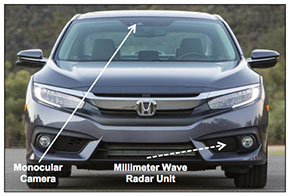

Collision Mitigation Braking System™ (CMBS™)
In a first for the Civic, all models with Honda Sensing™
offer the Collision Mitigation Braking System™
(CMBS™)4, one of the most sophisticated driver-assistive
technologies available. A millimeter wave radar unit, located behind the
front grille, and monocular camera, located between the rearview mirror and
windshield, scans traffic conditions ahead of the Civic.
When the system determines a collision is possible with a detected vehicle, the integrated Forward Collision Warning (FCW)5 system's visual and audible alerts prompt the driver to take corrective actions. The visual alert appears on the Multi-Information Display (MID). If the situation is not resolved, CMBS can apply different levels of autonomous braking action to help reduce vehicle speed and eventual collision forces, and therefore to help reduce the severity of a collision if the driver doesn't take corrective action on their own. The radar unit and camera work simultaneously and cooperatively to control the VSA10 modulator, which initiates any required braking.
Due to the effectiveness of its monocular camera, CMBS can recognize shapes and differentiate between a vehicle and a pedestrian, warning the driver in each case. See the 2016 Civic CMBS animation for an active representation of system operation.
It is important to note that CMBS cannot detect all objects ahead, nor is it intended to replace the driver's assessment of traffic conditions and control of the vehicle. The driver must intervene in certain situations, and must always be attentive when using the system. Although in many cases CMBS will stop the vehicle, it is not intended to apply enough braking force to prevent all collisions. Based on the conditions, the system also may not perform all visual- and audible-alert stages, and may instead automatically engage the brakes if the system deems it necessary. CMBS may be turned off by pressing the CMBS button on the left side of the dash.
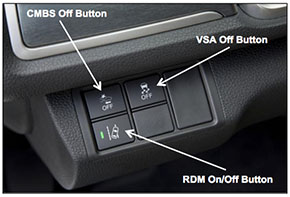

Forward Collision Warning (FCW) – Integrated with CMBS
In another Civic first, Forward Collision Warning
(FCW)5 is included in Civic trims with Honda Sensing™, and
on the Touring trim. Integrated with CMBS, Forward Collision Warning (FCW)
uses the monocular camera to detect vehicles ahead and to determine whether
a collision is likely. This reduces the stress of driving in traffic, while
also contributing to an increased level of passive safety.
If the FCW system detects a vehicle in front of the Civic and then determines that a collision may occur (due to a speed differential between the two vehicles), it will trigger visual and audible alerts for the driver. These include a "BRAKE" message on the Multi-Information Display (MID), and a series of beeps to alert the driver to apply the brake pedal. The FCW system will not automatically brake, and the driver remains responsible for safely operating the vehicle and avoiding collisions. If the driver doesn't respond to the FCW warnings, however, the CMBS is triggered into operation.
Drivers may adjust the distance at which FCW alerts occur by pressing the "SETTINGS" button, selecting "Vehicle Settings," and then choosing "Driver Assist System Setup" and the "Forward Collision Warning Distance" option. At this point they may choose between "Long," "Normal" or "Short." And if they choose to, drivers may also select "Off" to disable the FCW system entirely.
Note that the FCW system cannot detect all objects ahead and may not detect a given object; accuracy will vary based on weather, speed and other factors.

Lane Keep Assist System (LKAS)
Lane Keeping Assist
System (LKAS)8 provides a less stressful driving experience by
reducing the need for steering correction movements and driving effort on
the highway. LKAS uses a camera to read lane markings and uses the Electric
Power Steering to assist the driver in maintaining their position within
the lane.
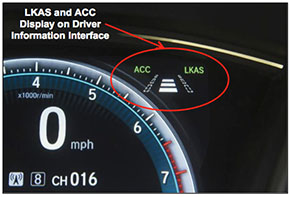
Designed for the U.S. road structure, the system uses a monocular camera mounted on the upper portion of the windshield to identify painted lanes, Botts' Dots and Cat Eye markers at speeds between 45 mph and 90 mph. When LKAS senses that the driver is drifting from the middle of a detected lane, the system generates corrective steering torque to assist the driver in maintaining lane position.
LKAS may be activated and deactivated using a switch located on the lower right part of the steering wheel (see Page 84). The system will suspend operation after several seconds if the driver takes his or her hands off the wheel, accompanied by a visual warning in the MID, resuming when the driver makes a steering input. See the 2016 Civic LKAS Animation for an active representation of system operation.

Road Departure Mitigation (RDM)
Integrating
LDW6 (see below), Road Departure Mitigation (RDM)7
uses a monocular camera (mounted on the upper portion of the windshield) to
identify solid or dashed painted lane lines, Botts' dots and Catseye
markers. RDM uses steering force, via EPS to help the Civic stay in its
lane and, if the vehicle is detected leaving a lane marked by solid lines,
braking force, via VSA10, to keep the vehicle from departing the
lane or roadway altogether.
The monocular camera recognizes lane features and identifies the lane. If the RDM system determines that the Civic is about to leave a detected lane, it will provide steering assist (primary) and in rare occasions when steering assist is not sufficient to avoid leaving a lane marked by a solid line, braking assist, to help the driver stay on the road. RDM is integrated with the Vehicle Stability Assist (VSA) system to provide moderate braking, and with the Electric Power Steering (EPS) system to provide steering input.
Multiple visual and audible warnings alert the driver when the RDM system is taking corrective action. These include a lane departure warning on the driver's Driver Information Interface (DII) along with an audible warning.
RDM also has a customizable initial warning of either a steering wheel shake/vibration, or an audible alert. This can be customized in the vehicle settings. RDM can be turned off by using the RDM Off button on the left of the dash (see Page 81). See the 2016 Civic RDM Animation for an active representation of system operation.

Lane Departure Warning (LDW) – Integrated with RDM
Lane Departure Warning (LDW)6 is designed to alert the
driver if the vehicle is leaving a detected lane without the turn signal
being activated. The system functions at speeds from 45 to 90 mph on
straight or slightly curved roads, alerting the driver of deviations from a
detected lane. The LDW system utilizes the same upper front windshield
camera used for CMBS® and LKAS8 and provides the visual and
auditory alerts prior to the other systems actively engaging.
If the vehicle begins to move out of a detected lane without the turn signal activated, LDW illuminates a Lane Departure message on the Multi-Information Display (MID) and sounds an audible warning, advising the driver to take appropriate action. The system can be activated and deactivated by pressing the LDW button located on the instrument panel, to the left of the steering column.
There are certain conditions under which the system may not engage or operate, including inclement weather (e.g., snow, ice or heavy rain) and extreme cabin heat (due to operability of the camera). The system will automatically suspend operation when the brakes are applied or the turn signals are used. LDW may not detect all lane markings or lane departures; accuracy will vary based on weather, speed and road condition. The driver remains responsible for safely operating the vehicle.

Adaptive Cruise Control (ACC) with Low-Speed Follow (LSF)
Adaptive Cruise Control (ACC)9, available on CVT
equipped models, allows the driver to set a desired speed and following
interval from a vehicle detected ahead, allowing the use of cruise control
in light traffic conditions. This significantly reduces the driver stress
of driving in traffic. The system uses the millimeter wave radar and
monocular camera to continually track the distance to the vehicle detected
ahead, and then adjusts the Civic's speed to maintain the set following
interval. A short, medium, long, or extra-long interval can be selected
(see Page 82 for ACC display on Driver Information Interface). When
required, the Civic autonomously brakes using the Vehicle Stability
Assist™ (VSA®)10 modulator.

Integrated Low-Speed Follow (LSF) extends the automatic following capability to stop-and-go traffic situations (down to 0 mph).
ACC operates in the following ways in the listed circumstances:
- A preceding vehicle is detected in the lane ahead – Decelerates automatically, if required, and then controls the following distance.
- The preceding vehicle slows to a stop – Stops automatically and remains stationary.
- The preceding vehicle accelerates from a stop – Resumes following when the SET or RES switch or accelerator pedal is operated.
- Another vehicle merges in between the Civic and the preceding vehicle – Automatically switches "targets" to the nearest detected preceding vehicle.
- The preceding vehicle exits the lane – ACC system continues at cruise-control speed previously selected by driver (25 to 90 mph).
A Driver Information Interface (DII) message and audible warning alert the driver when the ACC function is activated. See the 2016 Civic ACC Animation for an active representation of system operation.
Safety and Driver Assistive Features
|
Active Safety Features |
LX |
EX |
EX-T |
EX-L |
Touring |
|
Collision Mitigation Braking System™ (CMBS™)4 |
w/Honda Sensing™ |
w/Honda Sensing™ |
w/Honda Sensing™ |
w/Honda Sensing™ |
• |
|
Forward Collision Warning (FCW)5 |
• |
||||
|
Road Departure Mitigation (RDM)7 |
• |
||||
|
Lane Departure Warning (LDW)6 |
• |
||||
|
Vehicle Stability Assist™ (VSA®)10 with Traction Control |
• |
• |
• |
• |
• |
|
Advanced 4-Channel ABS |
• |
• |
• |
• |
• |
|
Electronic Brake Distribution (EDB) |
• |
• |
• |
• |
• |
|
Brake Assist |
• |
• |
• |
• |
• |
|
Multi-angle rearview camera with guidelines1 |
• |
|
|
|
|
|
Multi-angle rearview camera with dynamic guidelines1 |
|
• |
• |
• |
• |
|
Indirect Tire Pressure Monitoring System (TPMS)2 |
• |
• |
• |
• |
• |
|
Daytime Running Lights (DRL) |
LED |
LED |
LED |
LED |
LED |
|
Passive Safety Features |
LX |
EX |
EX-T |
EX-L |
Touring |
|
Advanced Compatibility Engineering™ (ACE™) body structure |
• |
• |
• |
• |
• |
|
Dual-Stage, Multiple-Threshold Front Airbags (SRS) |
• |
• |
• |
• |
• |
|
Driver Airbag with Spiral Technology |
• |
• |
• |
• |
• |
|
Safety vent passenger front airbag |
• |
• |
• |
• |
• |
|
Driver and Front Passenger SmartVent® Side Airbags |
• |
• |
• |
• |
• |
|
Side Curtain Airbags with Rollover Sensor |
• |
• |
• |
• |
• |
|
3-Point Seat Belts at all Seating Positions |
• |
• |
• |
• |
• |
|
Front 3-Point Seat Belts with Automatic Tensioning System |
• |
• |
• |
• |
• |
|
Lower Anchors and Tethers for Children (LATCH): 2nd-Row outer |
• |
• |
• |
• |
• |
|
Driver's and Front Passenger's Seat-Belt Reminder |
• |
• |
• |
• |
• |
|
Child-Proof Rear Door Locks |
• |
• |
• |
• |
• |
|
Driver Assistive Features |
LX |
EX |
EX-T |
EX-L |
Touring |
|
Lane Keeping Assist System (LKAS)8 |
w/Honda Sensing™ |
w/Honda Sensing™ |
w/Honda Sensing™ |
w/Honda Sensing™ |
• |
|
Adaptive Cruise Control (ACC)9 with Low Speed Follow (LSF) |
• |
||||
|
Honda LaneWatch™3 |
|
• |
• |
• |
• |
|
Expanded View Driver's Mirror |
• |
• |
• |
• |
• |
(See the Specifications and Features section for all data.)
1 Always visually confirm that it is safe to drive before backing up; the rearview camera display does not provide complete information about all conditions and objects at the rear of your vehicle.
2 For optimal tire wear and performance, tire pressure should be checked regularly with a gauge. Do not rely solely on the monitor system. Please see your Honda dealer for details.
3 Display accuracy will vary based on weather, size of object and speed, and the display may not show all relevant traffic. The display is not a substitute for your own direct visual assessment of traffic conditions before changing lanes.
4 CMBS cannot detect all objects ahead and may not detect a given object; accuracy will vary based on weather, speed and other factors. System operation affected by extreme interior heat. System designed to mitigate crash forces. Driver remains responsible for safely operating vehicle and avoiding collisions.
5 FCW cannot detect all objects ahead and may not detect a given object; accuracy will vary based on weather, speed and other factors. System operation affected by extreme interior heat. FCW does not include a braking function. Driver remains responsible for safely operating vehicle and avoiding collisions.
6 LDW only alerts drivers when lane drift is detected without a turn signal in use. LDW may not detect all lane markings or lane departures; accuracy will vary based on weather, speed and road condition. System operation affected by extreme interior heat. Driver remains responsible for safely operating vehicle and avoiding collisions.
7 Road Departure Mitigation only alerts drivers when lane drift is detected without a turn signal in use and can apply mild steering torque to assist driver in maintaining proper lane position and/or brake pressure to slow the vehicle's departure from a detected lane. Road Departure Mitigation may not detect all lane markings or lane departures; accuracy will vary based on weather, speed and road condition. System operation affected by extreme interior heat. Driver remains responsible for safely operating vehicle and avoiding collisions.
8 LKAS only assists the driver in maintaining proper lane position when lane markings are identified without a turn signal in use and can only apply mild steering torque to assist. LKAS may not detect all lane markings or lane departures; accuracy will vary based on weather, speed and road condition. System operation affected by extreme interior heat. Driver remains responsible for safely operating vehicle and avoiding collisions.
9 ACC cannot detect all objects ahead and may not detect a given object; accuracy will vary based on weather, speed and other factors. ACC should not be used in heavy traffic, poor weather or on winding roads. The driver remains responsible to slow or stop the vehicle to avoid a collision.
10 VSA is not a substitute for safe driving. It cannot correct the vehicle's course in every situation or compensate for reckless driving. Control of the vehicle always remains with the driver.
The Most In-Depth Honda Vehicle Shopper's Research - Anywhere!


